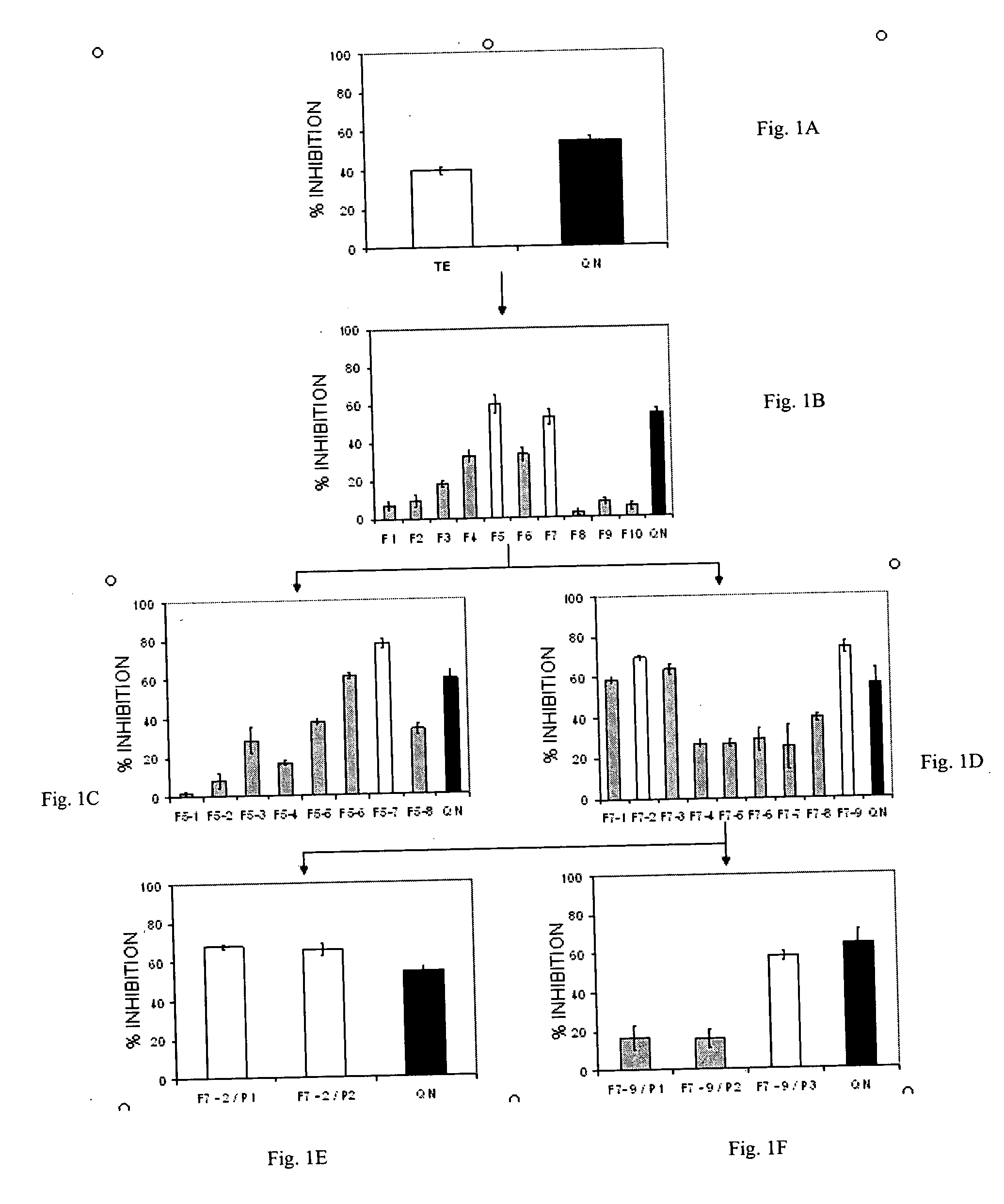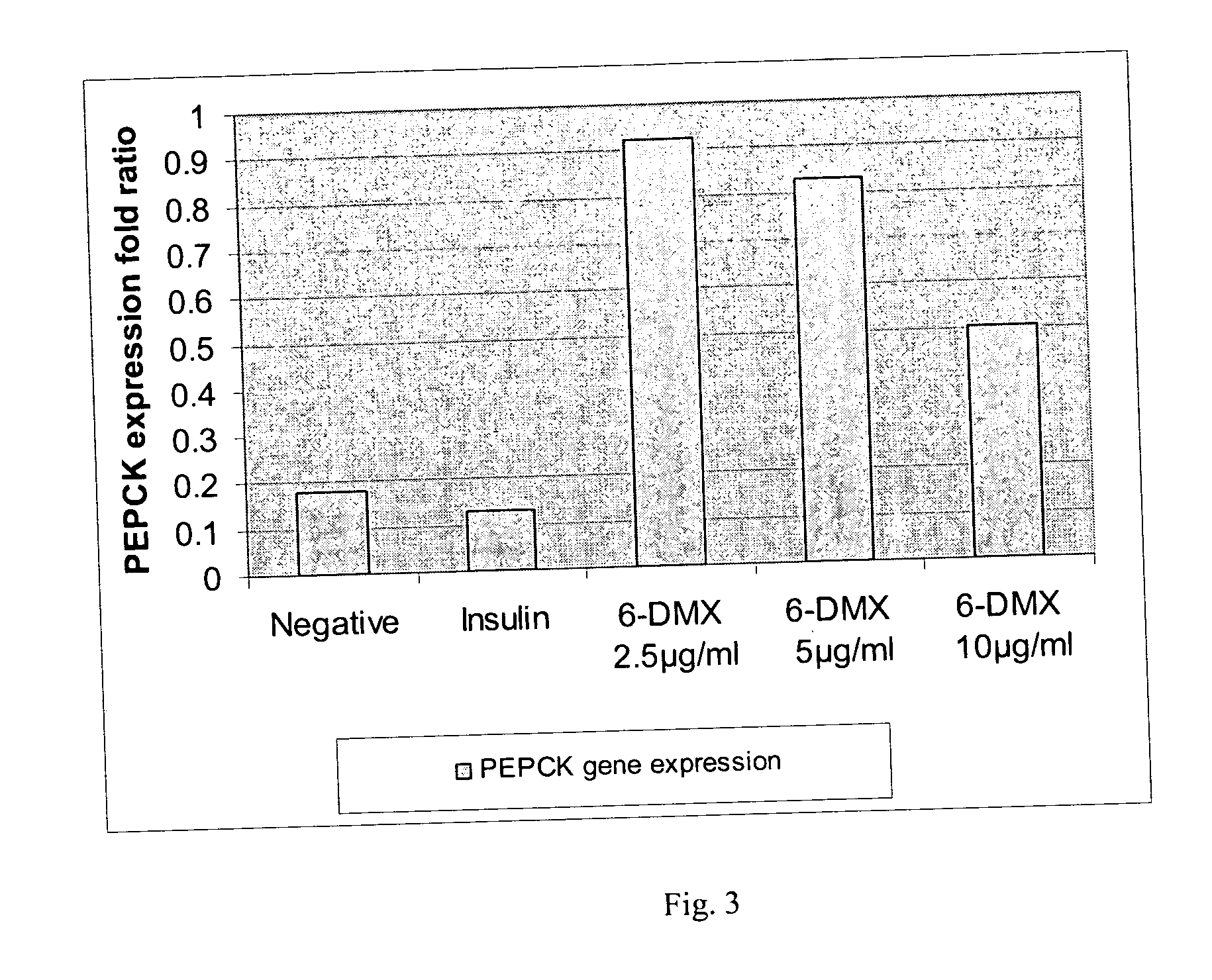Compounds from an extract of Artemisia and methods for treating disorders
a technology of artemisia and extract, which is applied in the field of compounds from artemisia extract and methods for treating disorders, can solve the problems of secondary health problems that require additional medical treatment, inability to control blood glucose levels, and inability to be useful indicators by themselves, and achieve the effect of inhibiting alr2 activity and pepck gene expression
- Summary
- Abstract
- Description
- Claims
- Application Information
AI Technical Summary
Benefits of technology
Problems solved by technology
Method used
Image
Examples
example 1
Extract Preparation
[0064] The seeds of Artemisia dracunculus L. were purchased from Sheffield's Seed Co., Inc. (Locke, N.Y.). The plants were grown in hydroponics and harvested as the total plant material above the root mass. The harvested plants were frozen and stored at −20° C. prior to extraction. Four kilograms of the shoot material was heated to 80° C., with 12 liters of 80% ethanol (v / v) for 2 hours. The extraction was continued for an additional 10 hours at 20° C. The extract was then filtered through cheesecloth and evaporated with a rotary evaporator and the final volume was reduced to 1 liter. The aqueous extract was freeze dried for 48 hours and the dried extract was homogenized with a motor and pestle.
example 2
Purification, Isolation and Identification of Compounds from the Extract
[0065] Purification and isolation of compounds were carried out using a preparatory HPLC from Waters consisting of W717 plus auto sampler, W600E multi solvent delivery system, W600 controller, W490E multi wavelength detector and Waters fraction collector. LC / MS system used for analysis includes the Waters (Milford, Mass.) LC-MS Integrity™ system consisting of a solvent delivery system with a W616 pump and W600S controller, W717plus auto-sampler, W996 PDA detector and Waters TMD Thermabeam™ electron impact (EI) single quadrupole mass detector with fixed ionization energy of 70 eV. Data were collected and analyzed with the Waters Millennium® v. 3.2 software, linked with the 6th Edition of the Wiley Registry of Mass Spectral Data, containing 229,119 EI spectra of 200,500 compounds. After the 996 PDA detector the eluent flow was split into two equal flow paths with an adjustable flow splitter, model 600-PO10-06 (An...
example 3
Liquid Chromatography-Mass Spectrometry Analysis
[0067] Substances were separated on a Phenomenex® Luna C-8 reverse phase column, size 250×4.6 mm, particle size 5 μm, equipped with a Phenomenex® SecurityGuard™ pre-column. The mobile phase consisted of two components: Solvent A (0.5% ACS grade acetic acid in double distilled de-ionized water, pH 3-3.5), and Solvent B (100% Acetonitrile). The mobile phase flow was adjusted at 0.5 ml / m, and a gradient of 15% B to 95% B over 30 minutes was used.
Physical Properties of Compound 1 (4,5-Di-O-caffeoylquinic acid)
[0068] UV λmax (acetonitrile): 218, 243, 327. EI MS m / z (% rel. int.): 182 (19), 163 (15), 149 (12), 136 (51), 123 (100), 110 (75), 94 (44); (−) ESI MS m / z (% rel. int.): 515 (100) [M−H]−, 1031 (4) [2×M−H]. 1H NMR (CD3OD, 300 MHz) 67 7.60 and 7.52 (1H each, d, J=15.9 Hz, H-7′, 7″), 7.02 and 7.00 (1H each, d, J=2.0 Hz, H-2′, 2″), 6.92 and 6.90 (1H each, dd, J=8.1, 2.1 Hz, H-6″, 6″), 6.75 and 6.74 (1H each, d, J=8.1 Hz, H-5′,5″), 6....
PUM
| Property | Measurement | Unit |
|---|---|---|
| Fraction | aaaaa | aaaaa |
| Fraction | aaaaa | aaaaa |
| Fraction | aaaaa | aaaaa |
Abstract
Description
Claims
Application Information
 Login to View More
Login to View More - R&D
- Intellectual Property
- Life Sciences
- Materials
- Tech Scout
- Unparalleled Data Quality
- Higher Quality Content
- 60% Fewer Hallucinations
Browse by: Latest US Patents, China's latest patents, Technical Efficacy Thesaurus, Application Domain, Technology Topic, Popular Technical Reports.
© 2025 PatSnap. All rights reserved.Legal|Privacy policy|Modern Slavery Act Transparency Statement|Sitemap|About US| Contact US: help@patsnap.com



